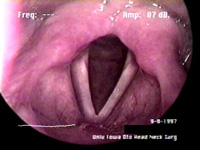the normal larynx
The three bears passage (above) is used to get a simple standardized profile of the voice. The patient is asked to read the passage as they would to a small child, imitating the voices of the three bears. While it is acknowledged that bears cannot speak, this is a useful way of eliciting high-pitched, medium pitched and low-pitched speech in a partially controlled way.
Video endoscopy allows photodocumentation of the state of the vocal cords. The standard pairing of maximum opening (inhalation) and prephonatory closure images (above) is used to compare preoperative images to postoperative results. When linked to a stroboscopy unit, videoendoscopy allows recording of the action of the vocal folds, and slow-motion analysis of the dynamics of any pathology and how it interacts with vocal fold motion (below).
|
